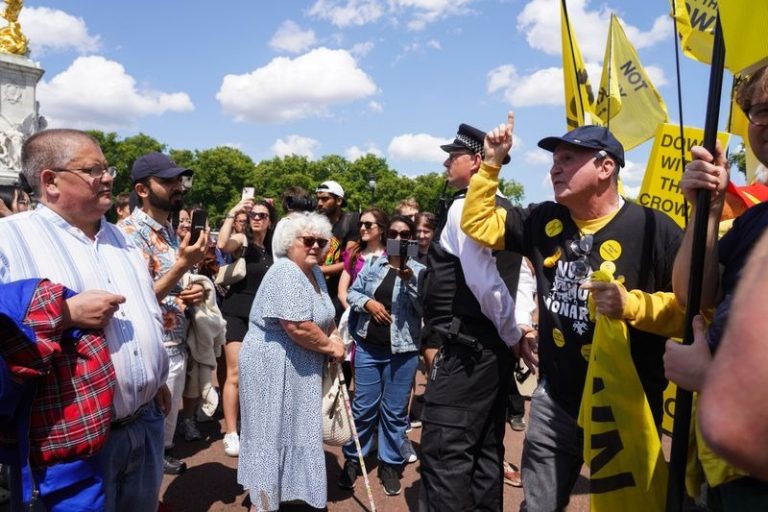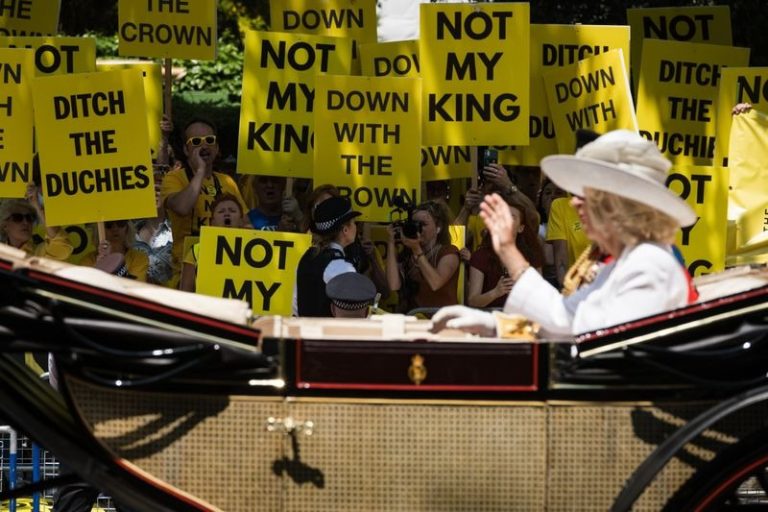London, UK – June 14, 2025 – Trooping the Colour, traditionally a majestic display of national pride and royal unity, saw an unexpected element this year as the youngest generation of royals came face-to-face with overt public protest. The annual King’s Birthday Parade, a spectacle of military pomp and circumstance, unfolded against a backdrop of vocal anti-monarchy sentiment, offering Prince George, Princess Charlotte, and Prince Louis an unfiltered glimpse into the complexities of their future roles.
During the iconic royal procession down The Mall, a striking image captured Princess Kate and her three children in their carriage, passing a contingent of demonstrators. Wielding vibrant yellow signs emblazoned with slogans such as “Not My King,” “Ditch the Duchies,” and “Down With the Crown,” the protestors ensured their message was unmistakable.
Despite the highly visible opposition, Princess Kate, 43, maintained her composure with remarkable grace. Her calm demeanor, showing no outward reaction to the chants and banners, underscored the unwavering poise expected of senior members of the Royal Family in the face of public criticism.

The demonstration was orchestrated by Republic, a prominent organization actively campaigning for the abolition of the monarchy. Graham Smith, CEO of Republic, had declared their intentions prior to the parade, stating, “Trooping the Colour is the key iconic royal event of the year. From now on, there will be protesters there, calling out the event and the monarchy as a superficial cover for a grubby and corrupt institution.” Smith’s remarks reflect a growing, albeit still minority, disillusionment with the institution.
However, recent YouGov polling, updated as of May 2025, presents a nuanced picture of public sentiment. While Republic actively works to sway opinion, the core members of the Royal Family continue to enjoy significant public approval. Prince William leads with a robust 75% approval rating, closely followed by Princess Kate at 72%. Even King Charles III, despite recent health challenges and a shorter reign, maintains majority support with 61% viewing him positively, compared to 29% holding a negative view. Support for the monarchy, however, does show a notable drop among younger demographics (18-25 year olds), with favorability for the King at 43% and 43% holding a negative view within that age group.

For Prince George (11), Princess Charlotte (10), and Prince Louis (7), this year’s Trooping the Colour was likely their most direct encounter with such opposition. Previously, their public appearances have been carefully managed, limited to celebratory events like Christmas walks or balcony waves. The sight of fervent protestors serves as a significant reality check: their royal status brings not only admiration and celebration but also scrutiny, dissent, and a call for change from a segment of the population.
For Prince George, in particular, the future monarch, witnessing dissent firsthand could be a foundational moment. It introduces him to the understanding that leadership in a modern monarchy is not solely about tradition and ceremonial duties, but also about navigating public debate and evolving societal expectations.

Despite the pockets of protest, the overarching atmosphere along the Mall remained largely positive, with royal supporters significantly outnumbering critics. The appearance of the Royal Family on the Buckingham Palace balcony was met with resounding cheers and applause. Prince Louis, true to form, charmed the crowds with his enthusiastic waves, even as Prince George playfully nudged his younger brother in a relatable moment of sibling banter.
While anti-monarchy protests are not a new phenomenon – Republic has been active for decades – the recent demonstrations, especially those targeting high-profile events like Trooping the Colour, highlight a shifting landscape. The new generation of royals is growing up in an era where the Crown is increasingly subject to public question and demands for accountability. This evolving environment is set to profoundly shape their roles, requiring a modern approach to their duties that previous generations may never have had to confront with such directness.


